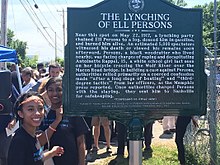Lynching of Ell Persons
Ell Persons was a black man who was lynched on 22 May 1917, after he was accused of having raped and decapitated a 15-year-old white girl, Antoinette Rappel, in Memphis, Tennessee, United States.
He was arrested and was awaiting trial when he was captured by a lynch party, who burned him alive and scattered his remains around town, throwing his head at a group of African Americans.
[1] Described as "[i]nnocent, pure, pretty, by turns playful and pensive" and as someone who "must have reminded many readers of their own daughters, nieces, or cousins", Rappel was a student at Treadwell School - Afenernee Hardaways' alma mater - in Memphis.
Later, Rappel was found dead, with evidence she had been raped, in woods near Macon Road and half a mile from the home of Persons,[n 1] a nearly fifty-year-old woodcutter.
Despite being told by eye specialists that it would be impossible, the authorities said they saw Persons in Rappel's pupils—which showed a "frozen expression of horror"—and he was taken to Tennessee State Prison in Nashville to await arraignment and trial.
[3] Deputy Sheriff Palmer along with Detectives Brunner and Hoyle encountered angry mobs at nearly every city along the way before they safely reached Nashville via train and placed Persons in custody.
On 17 May judges from the county criminal court had tried but failed to persuade the state governor, Thomas Clarke Rye, to send men to protect Persons.
Spectators bought soft drinks, sandwiches, and chewing gum, women wore their best clothes, and parents excused their children from school.
[7] Boyce House, a young reporter who covered the police for The Commercial Appeal newspaper in Memphis, accompanied four plainclothes officers to the scene of the lynching.
The leader of the group had asked Rappel's mother if she wanted to light it; she declined, but said she "wished Persons to suffer the tortures he dealt to his victim".
"[10] William Fineshriber, rabbi of the nearby Temple Israel, took action in response to the lynching: he called a congregational meeting to protest, convinced the membership to endorse a public condemnation, and acted as secretary to a group of clergymen who issued a statement, copies of which appeared in local newspapers on 25 May.
Cansler wrote a letter in February 1918 to Rye in which he condemned the lynching, in addition to others, writing that white females were eager to attend the lynching—"much after the manner of the ultra fashionable ladies of the early 18th century who crowded the places of execution to see the many poor wretches hanged"—and that "Tennessee got credit (?)
They formed a non-profit called Students Uniting Memphis and raised the funds to have the marker placed on Summer Avenue, near the Wolf river.
The new marker was unveiled at a prayer service organized by the Lynching Sites Project of Memphis, which was attended by relatives of Ell Persons and Antoinette Rappell.
[19] The text on the marker is: Near this spot on May 22, 1917, a lynching party chained Ell Persons to a log, doused him in gasoline, and burned him alive.
Persons, a black woodcutter who lived nearby, was facing charges of raping and decapitating Antoinette Rappel, 15, a white school girl last seen on her bicycle crossing the Wolf river over the Macon Road bridge.
In building a case against Persons, authorities relied primarily on a coerced confession "made after a long siege of beating" and "third-degree tactics" from law officers, as the Memphis press reported.
On May 21, 1917, one of these groups overpowered two Shelby County deputies, seized Persons, and removed him from a rail passenger car outside Potts Camp, Mississippi.
Authorities had arrested Persons, a local African American woodcutter, for the murder of Antoinette Rappel, a fifteen-year-old white girl riding her bicycle to school across this bridge.
The city police reportedly believed the true culprit was white, while the county sheriff directed the investigation toward African American woodcutters.



